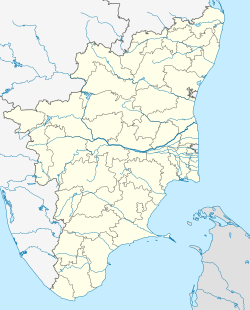Architecture
Athmanathar temple is a testimony to the temple architectural skills of ancient Tamil sculptors and engineers. The temple covers an area of over 10 acres (40,000 m2) with three enclosures and faces south, constructed so that the setting sun strikes the sanctum even though it is cloistered within three circumambulatory paths. The presiding deity is formless (Atmanatar); there is no Śivalingam but only a pedestal (Āvudayār) located in the sanctum, hence the name Avudayar Koil. [7] The God faces South in this temple- in Dakshinamurthy or Guru form. His consort is worshipped as Śivayoganāyaki (Yogāmbāl) in iconless form. There is no Nandi bull icon as is conventional in almost all Shiva temples. There is deep spiritual significance in this. Hinduism allows deity worship for the novice. As one's devotion matures, one begins to contemplate the truth of formlessness of the Brahman. The temple has been designed to illustrate this theology. This one of the rarest Saivite shrine in whole of India to portray the supreme truth symbolically. Since the soul ( athma ) has no form, the deity is called Athmanathar. [8] There are five lamps in the sanctum indicating the five time scales and 27 lamps indicating the 27 stars. [5]
Tirupperunthurai is also known as Kokozhi, Śivapuram, Ākāśa Kailāsa, Vadavūr, Chaturvedamangalam and Ādi Kailāsa in Sangam literature. It is also known as Atīta Sabhā as it has six Sabhā-s, namely Kanakasabhā, Chitsabhā, Satsabhā, Ānandasabhā, Ratnasabhā and Devasabhā in comparison to five Sabhas at Chidambaram, each of these halls is named after Shaivite theological terms. These halls have exquisite carvings. It is believed that Manikkavacakar himself built these sabhas, and covered the Sabhas with 21600 plates of copper. Mother Parvathi in the Thillai Mandap in the second prakara granting the Pasupatha weapon to Arjuna as hunter and his wife is very realistic in workmanship. Mother appears with a chain around the neck, bangles in hand and holding a bag each carved in stone. Iron screws are use in some of the mantapams, which is unique for that age.
The temple is noted for the zephyr (granite) roof work. The ceiling of the Kanga sabhai (golden hall) is a grandeur creation in stone. The ropes, rafters and nails all are made of granite. [9] The bow wielding Muruga, Kali and Siva's Rudra thandavam (wild dance) are the finest specimen in sculptural art. The five philosophies representing the Panchakshara the five letters – Na, Ma, Shi, Va, Ya – Nivrtti Kalā, Pratiśta Kalā, Vidya Kalā, Śānthi Kalā and Śāntyātīta Kalā are in sculpture form on the roof of the Panchakshara Mandap.
The composite columns of Virabhadra holding sword and horn are found be additions of the Vijayanayagara kings during the early 16th century. Similar columns of Virabhadra are found in Veerapthara swamy temple at Pasumbalur Village near Perambalur, Adikesava Perumal Temple at Thiruvattaru, Meenakshi Temple at Madurai, Nellaiappar Temple at Tirunelveli, Kasi Viswanathar temple at Tenkasi, Krishnapuram Venkatachalapathy temple, Ramanathaswamy Temple at Rameswaram, Soundararajaperumal temple at Thadikombu, Srivilliputhur Andal temple, Srivaikuntanathan Permual temple at Srivaikuntam, Vaishnava Nambi and Thirukurungudivalli Nachiar temple at Thirukkurungudi. [10]
Many renovations have been carried out, much of the current structure dates to the 15th century CE. The thousand pillared hall has several delicately crafted pillars with depictions of the Oordhwa Tandavam of Shiva, Karaikal Ammaiyar, Dhanurdhara Subramanya, etc.
This page is based on this
Wikipedia article Text is available under the
CC BY-SA 4.0 license; additional terms may apply.
Images, videos and audio are available under their respective licenses.

